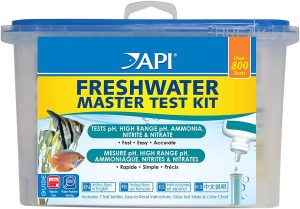All living things get ill – it’s a given. However, as we are primarily concerned with goldfishes, that’s what we are going to talk about today.
Goldfish diseases may not be an easy thing to pick. Especially if you are not familiar with your pet and the diseases it could acquire. Therefore, it’s crucial to understand the various common goldfish diseases that you’re most likely to come across.
It is not necessary that your goldfish is sick if it looks sick. The sick look your pet has can be the result of bad living conditions. As we all know that even the cleanest of water may contain much toxics. The same is the case with the water in the aquarium. There are many reasons that the water gets toxic, some of them are excreted by the fishes themselves.
The two main elements to toxicate the water are Ammonia and nitrate. Even the slightest percentage of these two can cause fish irritation and lethargy. If you lower the pH level of water it can cause many other problems as goldfish need the pH to be around 7.4.
But don’t worry, we will help you prepare for almost any disease thrown your way, metaphorically speaking.
Let’s begin!
Test the Water
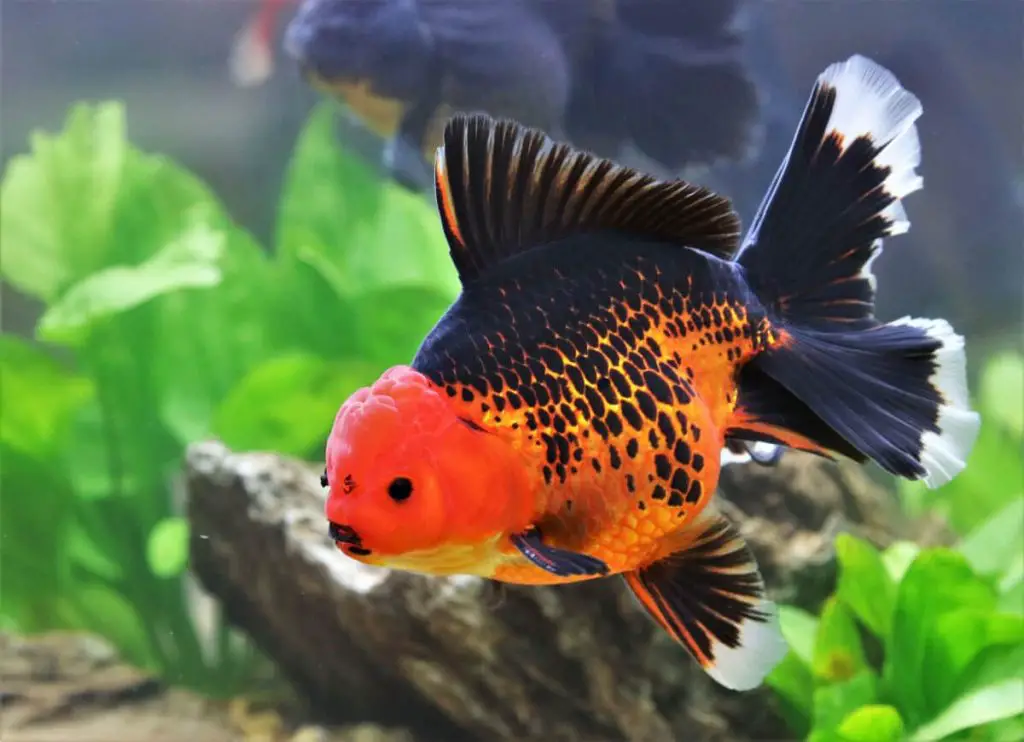
Goldfishes absolutely cannot survive in dirty water. Everything starts to go wrong with your goldfish if the tank water is contaminated. They will literally jump out of the tank instead of staying in that low-oxygen, polluted water. Crazy, right?
However, before you do anything, always test the water first.
For that, you can go for water testing kits to determine the poor water conditions. If there’s nothing wrong with the water quality – it’s about time you start wondering if your goldfish has contracted a disease or not.
The 17 Common Goldfish Diseases
We have narrowed down the most commonly encountered goldfish diseases that you should definitely know about. Take a close look at the symptoms and treatment options. However, it’s advisable to consult a vet before taking any serious action.
Velvet: Specks of Gold Dust
Starting off with our list of goldfish diseases is the Velvet disease. It is also known as “Goldust.” It’s caused by Oodinium and, as the name suggests, forms a not-so-soft, gold-colored coating on the goldfish.
As far as the causes are concerned, poor water conditions and stressed-out fish are more prone to this disease.
How can you tell that your goldfish is suffering from the velvet disease? Here are the symptoms that you’ll come across:
- Seems like sprinkled with yellow powder.
- Clamped fins
- Excess mucus production
- Labored breathing
- Rubbing against objects in the tank
Well, the chances of your goldfish having this disease are pretty low. But, nevertheless, suppose it does end up contracting the gold dust disease. In that case, the best treatment option is copper sulfate and aquarium salt.
Ulcers: Is that a Hole!?
One of the most problematic effects of a bacterial infection can be ulcers. Moreover, they have the potential to get really deep really fast. Because of such progress, it’s essential to diagnose and solve this issue as soon as possible.
Ulcers usually arise after a fluke infection. Probably because flukes are responsible for injecting several harmful bacteria into the goldfish’s skin. If it’s left untreated, well, all hell would break loose.
Here are the associated symptoms that you’ll find along with ulcers:
- Bloody patches
- Open sores on top of the fish’s head
- Deep holes with bordered skin hanging around it
Moreover, if your goldfish starts to pick on its wound and nibble on it – everything will eventually get worse.
All of this gets really out of control if the bacteria reach the organs. Once that happens, it can potentially kill the goldfish. The best approach for treating ulcers is to change the water and clean the ulcer with hydrogen peroxide.
Tumors: Fish Cancer, Really?
Cancer hasn’t spared the goldfish either. Goldfish can have tumors, and the reason behind their development is usually genetic or a viral infection.
Tumors are enlarged lumps of cells. Goldfish can have both benign and malignant tumors, with the latter being rare. However, if they are not treated in due time – it can kill the goldfish.
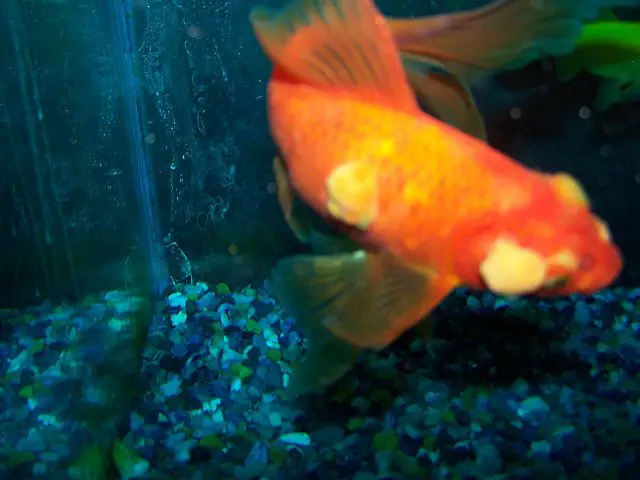
If there’s a tumor blooming internally or externally in your goldfish, here are the symptoms you’ll see:
- Goldfish refuses to eat
- Appears to be upset/depressed
- White, black, or pink mass on goldfish
- Mass can be lumpy or cauliflower-like
Tumors can be a little tricky to remove. Unlike anchor worms or flukes, where you could just use a tweezer to pluck them away, tumors require professional assistance. If you think it’s a tumor and matches the symptoms mentioned above, contacting a vet would be ideal.
Trichondia: Using Goldfish as a Taxi?
Let’s say that you got too enthusiastic and bought many new fishes, and got the aquarium super-crowded. Then, after some time, you see the goldfish in a frenzy. What happened? Well, trichondia happened.
Trichondia is a small external parasite that makes the life of the goldfish downright miserable. They mostly use them to move from one place to another, like a taxi. Obviously, this causes the goldfish to stress out like anything.
You can see the following symptoms if there is a Trichondia attack in the aquarium:
- Flashing
- Refusing to eat food
- Acting lethargic
- Clamped fins
Except for flashing, any of the other symptoms mean that the infection is incredibly severe.
For treatment, it’s advised to go for salts if there are one or two infected fish. It is advisable to keep the salt concentration anywhere between 0.3% to 0.9%.
But if there is large-scale involvement, potassium permanganate is the better choice.
Pop Eye: NOT the Eyes Man!
Popeye is exclusively a disease of the goldfish’s eyes. It occurs when there is fluid leakage behind the eyeballs of a goldfish and causes them to swell. Because of this swelling, the eyes (be it one or two) protrude out of the sockets.
This disease occurs as a result of trauma, infection, or toxic water conditions. Since eyes are involved in this one, it could lead to corneal damage as well.
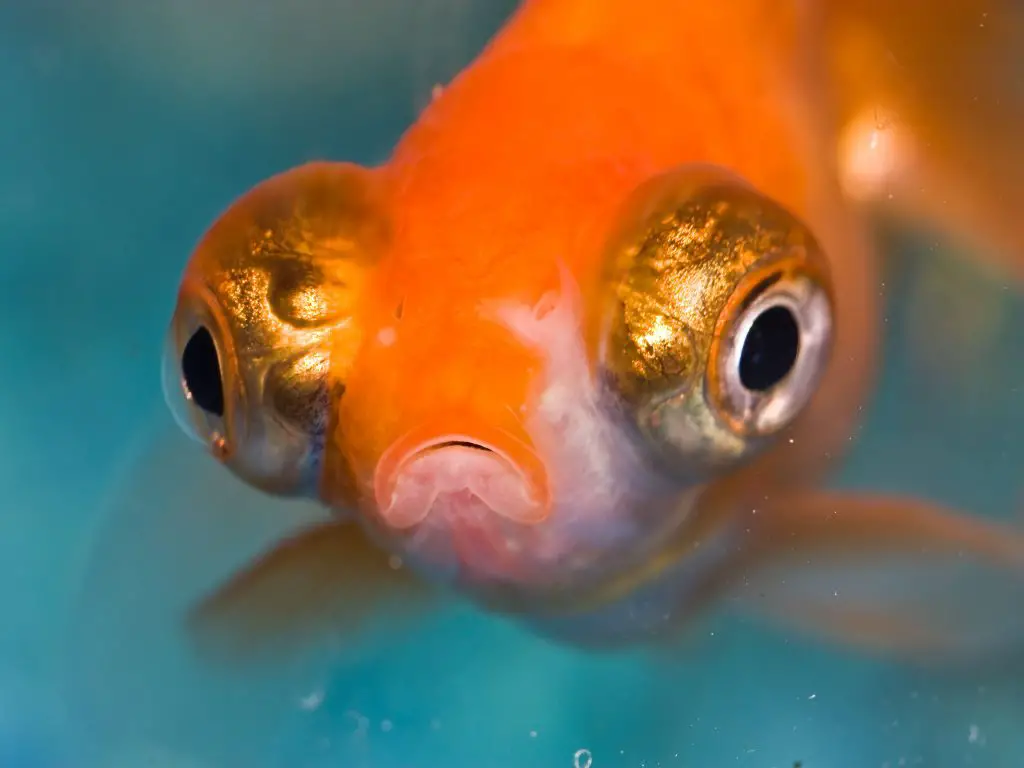
Here’s what you’ll see in the Popeye disease:
- Protruding eyes
- Swelling/Bags around the eyes
As far as the treatment is concerned, the primary approach is to determine the underlying cause. If there’s something wrong with the water conditions, fix that. If there’s a trauma or injury, salts baths can heal them. Whereas, for infection (such as Dropsy), treat it with proper medications.
Mouth Rot: Troubles with Eating
Mouth rot in the goldfish is pretty bad. Parasites are usually the cause behind this disease, which is reinforced by a secondary bacterial infection. If it’s not caught in the early stage, things could get really ugly really fast.
Although, the main culprit is overcrowding. Failure to identify it in the initial stages will eventually lead to the erosion of the goldfish’s lips, and the mouth loses its integrity on the whole.
If your goldfish is suffering from mouth rot, here are the noteworthy symptoms:
- Red mouth
- The goldfish will rub its mouth against the tank’s glass and decorative objects.
Mouth rot needs to be treated early, or else it’ll render your goldfish unable to eat for life. If everything with the water tank is top-notch, then it’s time to employ medicines. Hydrogen peroxide does a great job in helping with the wound, along with some aquarium salt.
Obviously, a problem with the goldfish’s mouth would cause it to stop eating. Once this happens, it wouldn’t take much time for the goldfish’s immune system to turn weak, eventually exposing it to various infections.
Lymphocystis: Causes Goldfish Disfigurement
Incredibly identical to carp pox, lymphocystis is caused by a virus. It is most likely to attack the goldfish with a weak immune system, probably because of the not-so-good water conditions.

It is also known as the “Cauliflower Disease.” Iridovirus is the causative agent of lymphocystis, causing goldfish disfigurement. Here’s what you will see:
- Enlarged, tumor-like masses
- White masses (maybe pinkish or grey as well)
- cauliflower-shaped lumps
- The preferable site is fins but can develop anywhere
Unfortunately, lymphocystis is not well-understood, and therefore we don’t know the cure. However, for accelerating the healing process, acriflavine is recommended.
Ich: Did Someone Sprinkle Snow on Your Goldfish?
White spot disease, referred to as ich and pronounced as ick, is another one of the goldfish diseases you must be aware of. It’ll appear as snow or salt sprinkled over the goldfish’s body and gills.
It’s a parasitic disease caused by Ichyophthirius multifilis (good luck pronouncing that), often found hanging out in the aquarium. This parasite infects the goldfish and starts feeding on its body cells and fluids – yikes!
However, it doesn’t surface until the tank water has gone really bad. Furthermore, introducing new fish without quarantining it for at least two weeks can also trigger this disease. Along with these, stressed-out or weakened goldfish or lowered temperatures are also common causes.

Your goldfish has white spot disease if it’s exhibiting an odd behavior that includes;
- loss of appetite,
- flashing or darting around the aquarium,
- scraping against the tank’s decorations
- deep, heavy breathing
- Flattened down fins
Ich is a highly contagious disease and requires prompt attention. All of your fishes need treatment if any of the goldfish has contracted this disease. Increasing the water temperature, adding salt to the tank, and going for white-spot medications; can be helpful treatment options.
Keep one thing in mind that it’s not necessary that every fish suffering from ich will show the white spots on their body. Sometimes it can be only behavioral symptoms. Likewise, it is not necessary that all fishes with white spots have an ich.
Hole-In-The-Head: Ulcers, Is that You?
Well, we know who is an expert in drilling goldfish’s bodies. That’s right, ulcers.
Once formed, these nasty issues only tend to get bigger and deeper with time. They arise as a result of bacterial infections. However, factors like; toxic water conditions and nutritional problems also play a vital role.
It’s caused by a protozoan known as Hexamita that commonly infects freshwater species. Also, referred to as the “Lateral Line Disease,” here’s what you are bound to come across:
- Cavities in the temples (that’s where the name comes from)
- Stringy, colorless (white) feces
- The appearance of eroding holes in the goldfish’s head
Metronidazole, an antibacterial medication, can help get rid of this disease once and for all. And perhaps, consider keeping the tank clean as well?
Fungus: What’s a Fungus Doing Here?
As if we didn’t have enough of the viruses and bacteria – fungus too decided to make an appearance. Great.
Fungal infections are common in a fish tank with dirty, toxic water conditions. They also occur if the goldfish has open, untreated wounds.
They are not as common as the other infections but can still appear every once in a while. The fungus can either end up involving the entire body of a goldfish or just the gills.
No matter what, fungal infections must be treated promptly to ensure the goldfish’s safety. It’s because fungus spreads quite fast, and if it ends up infecting the gills – a goldfish can be suffocated to death.
If your goldfish is infected with a fungus, you’ll probably see the following symptoms:
- White, cotton-like growths on the body or fins
- Furry masses on the body or fins
- Loss of interest in food
- Goldfish acts floppy or lethargic
To treat this, get your hands on antifungal medications. You can treat them with potassium permanganate or a salt bath as well.
Flukes: Are Those Vampires!?
Flukes are blood-sucking parasites that attack the goldfish’s gills (Dactylogyrus) and skin (Gyrodactylus).
Invisible to the naked eye, flukes can suck a goldfish dry. It uses its hooks to attach to the goldfish and keeps drinking its blood until there’s no blood left. Yes, like a ruthless vampire.
If you’ve bought a goldfish from the pet store, it’s probably (99% of the time) infected with flukes. The best way to prevent the spread of this disease is to always quarantine new goldfish.
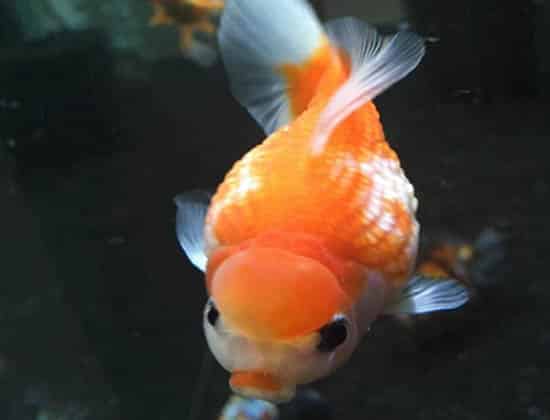
Flukes are caused by poor water quality coupled with overcrowded tanks and getting bullied by other fish in the aquarium. Moreover, goldfish that are overfed and stressed out most of the time are prone to this problem.
When talking about the symptoms, these are the ones you should be on the lookout for:
- Goldfish have clamped fins
- It’s flashing in the aquarium and rubbing itself against objects
- Breathing difficulties cause the goldfish to come up to the surface and breathe
- White or pale gills (color loss)
Because it is salt-resistant, you cannot treat it with salt. Therefore, treating with antiparasitic medications is the only way to get rid of flukes from your fish aquarium. We would not recommend you to use chemical-based medications to get rid of flukes.
Keep in mind that whenever you get a new fish from a pet store, quarantine it. As there is a 99% chance that the fish from the store may have flukes. So, it is better to take precautions than regret.
Fish Lice: What Are Those Bugs Around My Goldfish!?
If you thought that lice were only a “human problem,” – you couldn’t have been more wrong. Fish lice are a thing, and it’s one of the most irritating goldfish diseases to ever exist!
Fish lice don’t really penetrate the body. Instead, they move around with the goldfish and feed on its body tissue. The cause of this disease is Argulus (disc-shaped parasites) that usually infect wild fish raised in pond water. Therefore, quarantining and assessing the newly bought goldfish is incredibly essential to prevent the spread of this disease.
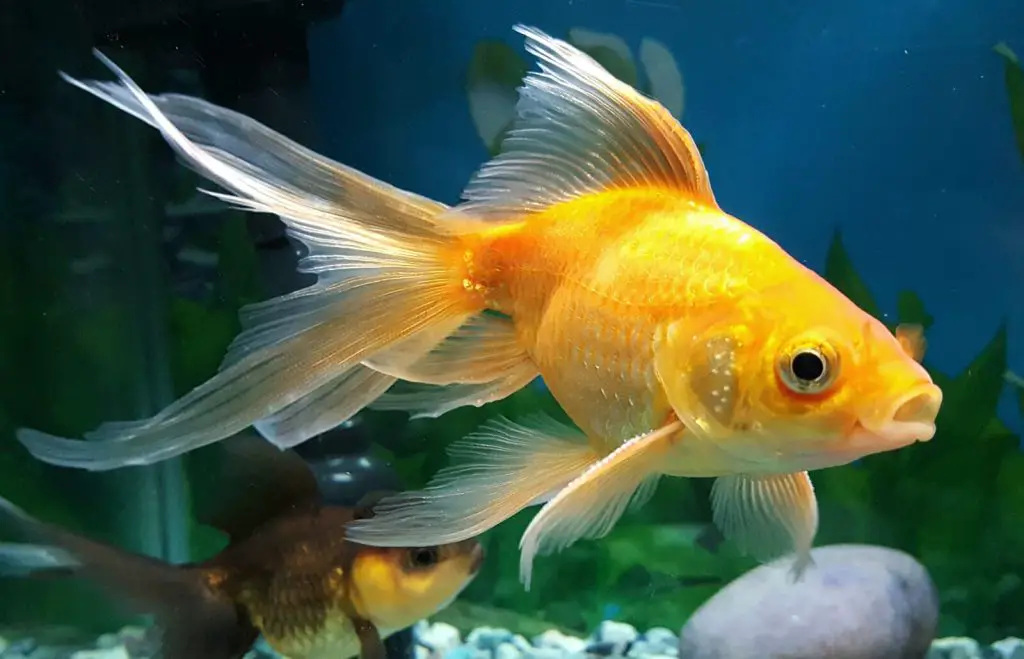
Following are the symptoms of this disease:
- Incredibly agitated and irritated goldfish
- Goldfish swimming around, scratching itself against anything solid
- As the disease progresses; you can even see bloody, red wounds on the body
- Upon close inspection, you can also come across green specks swimming around your goldfish’s body
Lernaeosis (anchor worm disease) and fish lice are quite similar when it comes to treatment. However, salt doesn’t really affect Argulus and requires extensive treatment.
Opting for antiparasitic medications can do the trick. If there are any apparent wounds, adding aquarium salt can accelerate the healing process.
Fin Rot: Fins, Beware!
Let’s get a little organ-specific, shall we?
Stressed-out goldfish due to poor water quality, continuously changing water temperature and pH levels, overcrowding, or bullying – can cause fin rot. It can also affect the goldfish’s tail and is then referred to as “Tail Rot.”

It can also attack those goldfish that weren’t treated for secondary bacterial infections. Let’s take a look at the symptoms of fish rot:
- Red-streaked, torn fins
- Frayed tail (tail rot)
- Ragged fins will eventually turn white
When talking about treatment options, it’s safe to not go for medications immediately. Instead, try treating the goldfish with hydrogen peroxide first. Then, improve the fish tank’s conditions and make sure that everything is ideal for the goldfish. Finally, if this doesn’t solve your issue, go for antibiotics.
Once you start seeing black spots instead of the red ones – congrats! Your goldfish is getting better!
Cloudy Eye: Is it Fog, or What?
Another goldfish eye problem – is the cloudy eye. It’s also known as the “White Eye” and is prevalent in fancy goldfish with protruding eyes. Probably because such eyes are more prone to bacteria and injuries.
Cloudy eye presents with the following symptoms:
- Bloodshot or milky eyes
- Hazy eyes
- Goldfish running into the decoration pieces in the aquarium
If you own a fancy goldfish, it’d be better to avoid sharp objects in the tank. For treatment, add some salt and adjust to the optimum temperature. Most likely, your goldfish will be able to recover in some time.
Carp Pox: Is Goldfish Pox a Real Thing?
Apparently, even goldfish can contract the herpes virus.
Carp pox is caused by the HPV-1 strain and is transmitted from one infected goldfish to another. Moreover, it’s most commonly known to infect goldfish and koi.

Mixing pond fish without quarantining them can cause carp pox. Here’s what you’ll come across as the symptoms:
- Thickened skin
- The appearance of whitish or pinkish waxy warts on scales or fins
- Milky skin lesions like drops of candle wax
Curing fish pox can be challenging – because there’s no cure! This disease comes and goes willingly, without any apparent reason.
The best thing you can do is to create ideal environmental conditions for your goldfish. This is achievable if you maintain the required warm temperature and dissolve some salt.
Anchor Worm: Is My Goldfish Getting Pimples?!
Continuing our list of goldfish diseases, next up is the anchor worm!
Anchor worm infects the goldfish leading to a disease of the freshwater goldfish known as Lernaeosis. It begins with a pimple-like infection and eventually progresses to the stage where you can actually see a stick-like worm hanging off it.
Here’s what you will see if your infected fish has lernaeosis;
- Inflamed, irritated skin
- Whitish-green worm poking its body
- Your goldfish will be rubbing its body against the objects in the tank to get rid of the worms
- Red, raised ulcers
Anchor worms are not easy to treat.
Use medications to kill the parasites first, and then pull the worms out with the help of tweezers. Attention! This is an incredibly delicate process and should be done with great attention. Keep in mind that salt cannot be used to treat anchor worms nor do most of the medications available on the market.
After pulling out the worms, treat your goldfish with hydrogen peroxide to prevent secondary infections. It’s a pretty deadly disease and requires early diagnosis. Anything otherwise usually results in the death of the infected fish.
Dropsy: Pine Cones, Anyone?
Allow us to make it easier for you; dropsy is when the goldfish’s kidneys fail.
The reasons behind dropsy can range from; viral and bacterial infections to poor water quality and poor diet. As a result, fluid-build up in their bodies leads to abdomen swelling and protruding eyes.

Dropsy has the following symptoms:
- Swollen bodies
- Bulging
- Scales sticking out of the goldfish’s bodies (characteristic)
As far as the treatment is concerned – it’s sad, but dropsy has no treatment. You can add some Epsom salt hoping for good news, but it’s not worthwhile. By the time you discover this disease, it’s too late for the goldfish.
Damage Assessment & Troubleshooting a Sick Goldfish
We understand that having a sick pet goldfish can be incredibly disturbing. Therefore, if your pet is unwell, it’s only natural to feel the same way. However, as mentioned earlier, instantly assuming that your goldfish is suffering from any goldfish diseases is somewhat a far-fetched reaction.
Most of the time, dirty water is the reason why your goldfish feels lethargic and seems down. Therefore, cleaning the tank, maintaining the necessary pH level, and ensuring there’s no ammonia build-up; usually ends up solving all the problems.
For testing the water you can simply use the water testing kit. Here you are looking for the levels of ammonia, nitrite, and nitrate. Your test results must show the ammonia and nitrite at 0ppm. Because of their toxicity, any amount of these two can cause sickness to your fish. Furthermore, if your test shows that the nitrate level is more than 30ppm, you should be worried about that. The last thing you need to keep an eye on during this test is the pH level, which must not cross the 7.4 mark.
But if this doesn’t help, and your goldfish is still irritated, lethargic, and swimming around like crazy – then yes, it’s actually sick.
Behavioral Symptoms
Is your goldfish refusing to eat? Or is it coming up to the surface to breathe? If yes, then indeed, these are odd behaviors that demand immediate attention.
Goldfish diseases cause a variety of behavioral symptoms. Read ahead to find out more about them.
Swimming Upside Down
When the goldfish starts swimming upside down, it may indicate swim bladder disease. Or a bacterial, parasitical, or viral infection of the goldfish. However, sometimes there’s no bladder problem at all.
Your goldfish may be swimming down if it has been overfeeding or suffering from constipation. Feeding them poor-quality food can also be a contributing factor. Trust us, your goldfish will stop swimming upside down once you have changed the dirty water and treat the underlying cause.
Spasms/Jerking
Has your goldfish been jerking or twitching around while swimming? Are you noticing spastic swimming movements instead of the regular ones? If that’s the case, then your goldfish is probably suffering from one of the many goldfish diseases.
It’s challenging to pinpoint the actual cause behind these odd movements. Still, it’s usually due to poor water quality, environmental issues, or parasitic infection.
Whatever the problem may be, it’s better to treat the root cause as soon as possible.
Sitting On the Bottom of The Tank
Goldfish take their sadness quite literally, and to communicate this emotion with their human friends – they sink to the bottom. They usually sit there idly, not being playful or their usual self.
If you’ve noticed this, it means that there’s a problem with your goldfish.
Sitting on the bottom of the tank covers a lot of issues at once. Inadequate levels of oxygen, immense boredom, carrying numerous eggs, suboptimal water temperature, or if it’s suffering from any of the goldfish diseases can cause this behavioral symptom.
Jumping Out of The Tank
Has your goldfish attempted this suicidal move? If yes, then well, it has had enough!
Extreme water conditions like; extremely cold or hot water and highly acidic or alkaline water can force your goldfish to jump out of the tank. To prevent this, always try to keep the tank water clean.
However, these are not the only reasons that motivate the fish to jump out of the tank. During the mating season, the urge of a male fish also compels them to jump out of the water.
You must not lose hope once you find a fish has jumped out of the tank. Because the fish has not dried up completely, there is a good chance that it can be revived. But don’t put a fish back in the water if you observe that they have concave eyes or gray eyes. As these are the clear signs that the fish has died.
Gasping At the Surface of The Water
The goldfish coming up to the surface to breathe and quickly swimming down is a dead giveaway that there’s something wrong with the tank. It’s most likely raised levels of ammonia or nitrite that make the water too toxic for the goldfish to breathe in it. This behavior from the fish also implies that the oxygen level inside the aquarium is very low and the water needs to be changed.
Flashing (Darting/Scratching)
One of the most common signs of your goldfish being distressed is erratic swimming. Goldfish darting across the tank and scratching against the glass or objects in the tank is known as flashing. Several goldfish diseases have this behavioral symptom in common.
Clamped fins
While clamped fins are not specific to any goldfish illnesses, it’s still a notable behavioral symptom. It usually occurs as a result of a parasitic infection affecting the fins of your goldfish.
This symptom allows you to diagnose diseases early, making it possible to treat them before things get out of hand.
Acting Lethargic
Goldfish normally are very playful and cheerful fish. Most of the time they are moving around and exploring the aquarium.
But if you notice that your goldfish isn’t as playful as it used to be. If it’s spending most of its time at the bottom of the tank, doesn’t play around, or looks disinterested in almost everything – check the tank!
There’s probably something fishy with the environmental conditions.
Spitting – Says No to Food
Do you skip meals when you’re stressed? If yes, then you and the goldfish have something in common. Stressed-out goldfish usually don’t eat food, so it’s crucial to keep the tank conditions up to the mark.
If your goldfish is eating food, only to spit it out after some time indicates a serious problem. Dropsy, which causes the belly to swell due to fluid build-up, is one of the reasons why it would be spitting food out.
Floating On Side
Come on, let the goldfish have some fun!
Goldfish floating on its side could be very normal. But if it’s coupled with a skinny body, then it’s high time you start worrying about nitrite poisoning.
Physical Symptoms: By Body Parts of a Goldfish
Now that we are done with the behavioral symptoms, let’s talk about the physical ones. Most of the time, it gets easy to figure out various goldfish diseases just by looking at the physical appearance of a goldfish.
Every disease has its unique features and favorite area of attack. First, let’s take a look at the physical symptoms that you can frequently come across.
Stool
Checking out your goldfish’s stool can help answer some questions.
White Poop: Is that a Trail?
This one seems a bit funny but indicates a severe problem.
Usually, goldfish poop looks like whatever goldfish eat. But if there’s no food in the poop due to poor diet or some intestinal bacterial infection– white trailing poop is what you’ll see.
Air Bubbles in Poop: How About Some Floating Poop?
So, goldfish poop is supposed to sink, not float. But if it does, then it means there is a problem.
If your goldfish’s diet is only dry flakes and nothing else, then this can cause goldfish’s poop to float. Moreover, if oxygen levels are compromised, you can also expect to see air bubbles in goldfish poop.
Gills
Try looking at the gills to figure out the actual problem.
Red Gills: Is that Blood?
Usually, gills are red, and they may appear even redder if your goldfish is of silver or white color. However, if there’s an infection or ammonia poisoning in the water tank, it could indicate inflammation or swelling of the gills.
Pale Gills: Color Loss or What?
Well, pale or colorless gills usually indicate an infection. Do you remember the blood-sucking flukes? If yes, then be known that they are the most common reason behind your goldfish having pale gills. Those blood-sucking monsters suck the poor goldfish dry!
Holes In Gill: I’m Not Bulletproof, Got Everything to Lose
No, we don’t actually mean bullet holes in the goldfish’s gills. But what we do mean by this physical symptom is – infected fish alert!
While bacterial infection will subside once and for all, the holes wouldn’t go away.
Eyes
It’s all in the eyes, chico! They are pretty helpful in figuring out many goldfish diseases!
Missing Or Damaged Eyes: No Eyes, What!?
Most of the time, goldfish damage their eyes and end up turning blind by running into sharp, decorative items in the tank.
Yes, it’s not an illness or one of those freaky goldfish diseases that cause goldfish to turn blind – it’s the objects in the tank. Therefore, when shopping for the fish aquarium, next time, kindly go for toys and decorations that are not harmful to your goldfish.
Whitish Eyes: Is that Cataract?
In fish language, you wouldn’t exactly call it a cataract but the work of a bacterial infection. However, the white or cloudy eyes can be a possibility if your goldfish is bumping into everything in the fish tank.
Moreover, chemicals like ammonia can also cause the clouding of the eyes.
Bulging Eyes: What’s with All That Ogling?
Your goldfish is not exactly ogling. It just has bulging eyes.
Goldfish can have bulging eyes due to bacterial infections such as Pop-eye. Furthermore, it can also be a symptom of unequal growth due to poor food and water quality.
Mouth
What’s stopping you from inspecting your goldfish’s mouth?
Red Mouth
A red, inflamed mouth and the goldfish rubbing it against the tank glass or other objects point towards fish mouth rot.
Mouth Stuck Wide-Open
Usually, this happens as a result of something stuck inside the goldfish’s mouth. If that’s the case, you can remove it manually with the help of tweezers to solve the problem. However, sometimes due to poor water conditions, the goldfish forces its mouth open, gasping for air.
Mouth Opening to One Side Only
Don’t worry if you find out that your goldfish opens its mouth to only one side. It’s a genetic condition and not an alarming situation – so chill out.
Scales
Don’t forget to pay attention to the scales. They are vital as well.
Scales Coming Off
Losing scales is not typical for the goldfish. It only happens when there’s a physical injury or is a result of flashing. Flashing is when the goldfish moves around the water tank like crazy and reacts to a parasitical infection.
Furthermore, if the decorative items in the tank are too small for your goldfish to fit through, they can also cause the scales to come off.
Peeling of Scales
Yes, it’s as uncomfortable as it sounds. Peeling of scales occurs due to burn injuries. If optimum pH levels in the water tank are not maintained – that’s when you’ll most likely see this happening.
Scales Sticking Out from Everywhere! (Pine-coning)
When the goldfish experiences kidney failure, it swells up. This causes the scales to stick out in a pine-cone fashion, almost similar to a porcupine. Such a condition coupled with visible physical symptoms indicates Dropsy.
Tail & Fins
Moving on to the following, must-be-looked-at components of a goldfish; tail and fins!
Tears/Splits in Tailor Fins
Tears in the goldfish’s tail or fins point towards fish rot, where it seems like everybody part of the goldfish is tearing away. However, getting in a fight with other fish in the tank can also cause splits in the tail.
Frayed or Shredded Tail or Fins
Coming across such a sight is painful, and it’s even more painful for the goldfish. Frayed tails or fins are a classical feature of fish rot. But increased levels of ammonia, nitrites, or even certain parasites can cause your goldfish’s tail or fins to assume this appearance.
Milky Film on Fins or Tail
If you see this prominent, milky layer on the goldfish’s tailor fins – then it’s probably because of two things. Either excess mucus production can cause this physical symptom or poor environmental conditions of the tank.
Bloody Streaks on Tailor Fins
The appearance of bloody streaks or spots on the tail of fins of your goldfish is a threatening condition. It usually is a response to the toxic water conditions of the water tank that caused the blood vessels to hemorrhage.
Moreover, bloody fins can also be a sign of fish rot.
Belly
Inspecting the belly can help you reach a conclusion. So here’s what you’ll probably see when it comes to your goldfish’s infected belly.
Swollen Belly
A bulging abdomen can be due to three possible reasons. Firstly, it could occur as a result of build-up eggs in the abdomen. For this, hand-spawning can allow the release of the eggs once and for all.
Overfeeding also causes your goldfish’s belly to swell up, and Dropsy (goldfish kidney failure) will also show this symptom.
Sunken Belly
When the goldfish’s belly starts thinning away, it probably means it’s not being fed well. To take things up a tiny notch, if the water conditions are healthy and you still notice this, then flukes can be a reason for this too. Apart from all these, high levels of ammonia can also cause a sunken belly.
Red Belly
A red belly is always the indication of nitrite poisoning gone out of control. So yes, if your goldfish has a red belly, there are no chances for its recovery.
Bent Back
Ever heard about scoliosis?
Scoliosis is a genetic disease that causes the goldfish’s back to assume an “S” or “C” shape. When this happens, it appears as a bent back.
Skin
Being the largest of the body, skin can show some very prominent symptoms of goldfish diseases. Check them all out!
Worms Sticking Out of Body
When you can see actual worms sticking out of the goldfish’s body – those are known as anchor worms. It’s a highly infectious and deadly disease that needs immediate treatment, or else your goldfish will die pretty soon.
White Film on Body
As with most goldfish illnesses, the appearance of a white film on a goldfish’s body can probably mean one of the two things. It’s either an infection or a reaction to the aquarium’s poor water quality.
A milky film is formed due to hyperactivity of the goldfish that leads to excess mucus production.
White Spots
Any goldfish with white spots all over its body is suffering from white spot disease. It can also appear as if someone sprinkling salt all over your goldfish.
Ich (common name for white spot disease) is the main culprit for this skin manifestation.
Red Spot(s)
Red spots are usually ulcers that may develop as a complication of parasitical infection. Therefore, while treating parasites, it’s essential to treat secondary bacterial infections to prevent ulcers. Sores, another name for ulcer, can penetrate deep enough to cause significant organ damage.
Raised Lumps
If you see big masses on your goldfish, no matter which color, then these are probably tumors. Tumors can either be cancerous or noncancerous. Try treating them as soon as possible because they can cause the goldfish’s death if left untreated.
Pale Color
One of the most common reasons behind a goldfish losing its color is not enough light! The goldfish has pigments that react with light to produce different colors. So, if the tank is not receiving enough sunlight, your goldfish will look paler than usual.
Furthermore, raised levels of ammonia or nitrite and fluctuating pH levels can also cause the goldfish to lose color.
Soft, Fluffy Patches
Don’t fall for their cute name.
These soft, fluffy, cotton-like patches develop due to a fungal infection. They can be found on the head, body, or fins and are not that easy to recognize. You might need a veteran’s professional help and a microscope to be 100% sure!
Black Spots
Black spots or smudges are all fine if they do not appear in cycles. As the goldfish age, they tend to lose their vibrancy and go towards the black shade. However, if these black spots come and go, they could be concerning as they represent a recurring problem.
If this is happening, it could indicate your goldfish getting bullied or an issue with the water tank.
Conclusion
And that’s all about goldfish diseases, their signs and symptoms, and what you can do to fix them.
By now, you can tell that goldfish do get stressed-out, bored, and don’t want to eat at times too. It shows that they are not just decorative items in your aquarium – they are living things that need proper care and attention.
ALWAYS REMEMBER to keep the water clean and maintained. You’d get rid of 99% of all the problems this way. However, that 1% requires medications and a proper treatment plan.
If your goldfish is suffering from any illness – don’t panic. Instead, try finding out solutions to the issues, and get professional help pronto!
Don’t give up on it, and strive for better environmental conditions next time. Don’t forget to quarantine any new fishes that you buy from the pet store.

